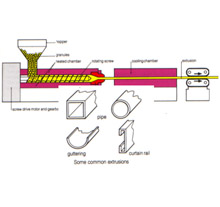

 Product Design
Product Design

 Rapid Prototyping
Rapid Prototyping
 CNC Prototyping
CNC Prototyping Rapid Prototyping
Rapid Prototyping Stereolithography Apparatus (SLA)
Stereolithography Apparatus (SLA) Selective Laser Sintering (SLS)
Selective Laser Sintering (SLS) Fused Deposition Modeling (FDM)
Fused Deposition Modeling (FDM) Laminated Object Manufacturing (LOM)
Laminated Object Manufacturing (LOM)
 Custom Molds - Plastic Molds
Custom Molds - Plastic Molds

 Plastic Molding
Plastic Molding

 Production Tooling
Production Tooling

Plastic Molding – Extrusion Molding
 Extrusion is quite like squeezing toothpaste out of a tube. Anything that is long with a consistent cross section is probably made by extrusion. Common examples are optical fibers, candy canes, plumbing pipes, chewing gums, drinking straws, door insulation seals, steel or aluminum I-beams, and spaghetti.
Extrusion is quite like squeezing toothpaste out of a tube. Anything that is long with a consistent cross section is probably made by extrusion. Common examples are optical fibers, candy canes, plumbing pipes, chewing gums, drinking straws, door insulation seals, steel or aluminum I-beams, and spaghetti.
The plastic extrusion molding process typically begins with a thermoplastic in the form of pellets or granules. These are usually stored in a funnel-shaped receptacle called a “hopper” before being moved to a heated barrel. After melting the plastic is forced through an orifice, usually a custom steel die shaped like the cross-section of the intended part, forming a tube-like or rod-like continuous workpiece. Cooling of this workpiece should occur as evenly as possible.
Most thermoplastics can be used for extrusion molding. Materials of greater strength in the molten state are usually preferred since they are easier to form and better maintain the intended shape. Other considerations that may affect material selection are heat and UV stability (for longevity), flame and chemical resistance (for safety), and strength and flexibility (for utility). Common plastics used in extrusion molding processes are
- Acrylonitrile Butadiene Styrene (ABS)
- Acrylic
- Polycarbonate (PC)
- Polyethylene (PE)
- Polypropylene (PP)
- Polyester
- Polystyrene (PS)
- Polyvinylchloride (PVC)
 We are constantly looking for new products in order to grow our business and Invention Home has enabled us to streamline that process much more quickly.
We are constantly looking for new products in order to grow our business and Invention Home has enabled us to streamline that process much more quickly. Marsha Dunmyre
CA, U.S.A
Cool Prototyping Copyright 2008-2009 © All Rights Reserved. Rapid Prototyping

